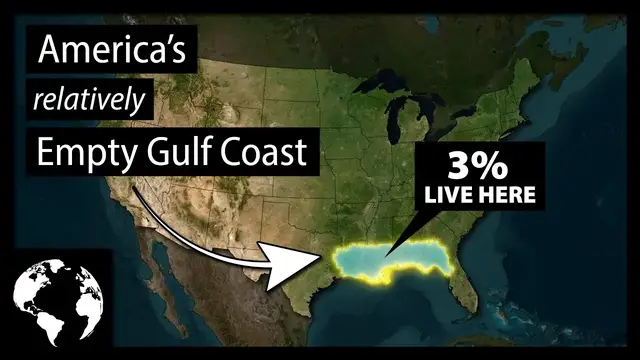The Gulf Coast of the United States is a beautiful area with miles of beaches and weather that most regions of the world would love. Despite this, a large section in the middle of the Gulf Coast has very low population compared to Texas and southern Florida. And there's a reason for that!
Show More Show Less View Video Transcript
0:00
The Gulf Coast is truly a beautiful part of the United States
0:04
Its beaches stretch for literally hundreds of miles and, outside of an occasional tropical storm
0:09
is blessed with weather that most regions in the world would beg for. And on top of it all, this particular area of the United States is in a well-developed region of the country as a whole
0:18
So why don't more Americans live in this particular area of the Gulf Coast
0:26
Hello and welcome to Geography by Jeff. Have you ever thought about the Gulf Coast of the United States
0:32
Technically, it's a large area that extends all the way from the bottom of Texas to the tip of Florida
0:37
But what we're most interested in this video is a particular section of the Gulf Coast
0:41
that appears to be underpopulated compared to the rest of the eastern United States
0:45
And we're going to explore why that might be today. But first, if you like my videos and you love geography
0:51
be sure to check out my podcast, Geography is Everything. This week, we're going to explore the geography of skyscrapers
0:58
You can listen to a new episode every Wednesday right here on YouTube, Substack where there's exclusive content, or whatever app you use to listen to podcasts
1:09
Now, if you follow my channel, you might recognize that I've created a similar video a couple months
1:14
ago on America's Empty Belt, where we explored why there's such a huge swath of land in the
1:18
middle of the country with so few people relative to most other regions of the country. But the area
1:23
we're talking about today is quite different. For one, if we look at this map of the United States
1:28
at night, you can see a clear line where the development pattern of the US shifts from a high
1:32
density of cities and towns to sparse development. The Gulf Coast area that we're talking about today
1:37
exists fully within this eastern side of the country with more cities and towns, but that just
1:41
makes it all the more interesting. With over 250 million people living in the eastern side of the
1:46
country, our Gulf Coast region has approximately 10 million people, and given its location, there
1:52
should probably be more, primarily because, unlike the middle of the country, this region
1:56
is relatively comfortable in terms of weather. If we look at the Coppin method of determining
2:01
climate types across geographies, we can see that the entire region of our Gulf Coast would
2:05
be listed as temperate with consistent precipitation, but hot summers. This makes it particularly
2:10
well suited for people to live there so long as you don mind the humidity The southern half of Florida which has largely the same climate has seen incredible growth over the last few decades largely due to people fleeing the cold north Additionally
2:24
unlike some other areas of the country, this region is not lacking in water. In addition to
2:29
the Mississippi River running through it, which is one of the world's largest rivers, there's also
2:34
the Alabama River, another major river, and many more tributaries in the region. Suffice to say
2:41
a lack of water is also not to blame for the relatively low population
2:45
And while today the region is underpopulated, at one point in history, the area did experience explosive growth
2:52
Between 1800 and 1900, the entire region we're talking about today grew from just a few thousand people overall
2:58
to well over 1 million people by 1860. But it's worth pointing out that most of those people were, in fact, slaves
3:05
While we'll never know exactly how many slaves lived within our region specifically, the slave population in Mississippi by 1860 is thought to have been about 55% of the total
3:13
population. So it's probably safe to say that at least half of the total population were enslaved
3:18
during this period until after the US Civil War, which leads us to our first huge exodus of people
3:23
from the region. The Gulf Coast region is a beautiful part of the United States. Amazing
3:28
beaches, eclectic cultures, and southern hospitality all combine to make a region that you would think
3:33
there would be at least one major city. But outside of New Orleans, which isn't even in the
3:37
top 40 of metro areas, all of its cities are pretty small. And there's a reason for that
3:42
But before we get into why the Gulf Coast has so few people living in it, if you're enjoying this video, hit that subscribe button
3:48
More fun geography videos are just a single click away. During the early part of the 1800s, the northern states had always been a place for people to
3:59
escape to when they were fleeing slavery. So it should come as no surprise that
4:03
After slavery ended, newly freed peoples began to move to other regions of the country
4:08
At this time in the United States history, the majority of people in southern states were black
4:12
But with freedom, this meant that they could go anywhere. And, in particular, if they could afford to move
4:18
they chose to move either north or west rather than stay in the south
4:21
But it wouldn't be for another few decades that we begin to see a huge exodus of African Americans move north
4:27
Starting around 1910, we see the beginnings of the Great Migration, wherein over the course of a few decades
4:33
roughly 6 million African Americans moved north in order to escape the harsh Jim Crow era laws of the South But it wasn exclusively about persecution It also had a lot to do with the economy as well
4:43
The southern part of the United States has always relied more on agriculture than the North
4:47
And while at one point this was an economic boon for the South, as the world began its rapid industrialization, the North quickly outpaced the southern states
4:55
This was felt particularly hard during the 1920s and 1930s when people began to move en masse
5:00
to cities where factory jobs and a middle-class lifestyle awaited them. This was exacerbated during the Great Depression when agriculture was hit particularly hard
5:08
and rural jobs dried up. While the southern region of the US did have some industry
5:13
it overall paled in comparison to places like Detroit, Pittsburgh, Cleveland, Chicago
5:19
New York City, and many more cities. Industrialization, of course, is no longer really a factor today
5:24
but it's left a lasting legacy on the entire region we're talking about. Let's get this out of the way to start. People do move to this region at large. The states of
5:36
Louisiana, Alabama, Georgia, and of course Florida have all grown between 2010 and 2020. Mississippi
5:43
shrank by less than 1%, but by and large, people do move here. However, if you're noticing a trend
5:50
you're not mistaken. Florida and Georgia grew much faster than our other states
5:54
and most of the growth in those states are not near our Gulf Coast region. If we look at the
5:59
major cities in our region. Aside from two, most are suffering pretty anemic growth. New Orleans
6:04
grew by about 11% since 2010, and Tallahassee grew by 8%. But Lafayette, Louisiana, Baton Rouge
6:10
Louisiana, Jackson, Mississippi, Mobile, Alabama, Montgomery, Alabama, and even Pensacola, Florida, all had pretty slow growth or shrank over this time period. And one of the most basic reasons
6:22
why people appear to be staying away from this region seems to be the lack of jobs at large made
6:27
worse by having poor infrastructure. According to the American Society of Civil Engineers
6:31
Louisiana and Mississippi were each given a grade of D plus in their latest report card
6:36
with roads, bridges, and drinking water all taking pretty big hits. Alabama manages a C- overall
6:42
not great, but at least better. Georgia and Florida both achieved better grades
6:46
but our Gulf Coast region is not receiving the bulk of their investments. And this trickles down
6:51
With the lack of investment in infrastructure industry is not likely to move to the region And without a vibrant industry and economy things like education rates suffer Mississippi Louisiana and Alabama
7:01
all have some of the lowest rates of bachelor degrees in the country. This doesn't mean people
7:06
from those states aren't getting college degrees, but it does mean that they're not staying. And
7:10
especially things like the current Jackson-Mississippi water crisis doesn't exactly help things look
7:15
better. After all, would you move to a state that has undrinkable water? But two other kind of recent
7:20
events hit the region really hard. You really can't talk about this specific region without
7:28
talking about two major catastrophic events, Hurricane Katrina and the Deepwater Horizon
7:33
oil spill. In 2005, a Category 5 hurricane slammed into the entire region today, but particularly New
7:40
Orleans. The devastation of the city and many coastal cities and towns in the entire region
7:45
was phenomenal. Between 2000 and 2010, New Orleans lost about 30% of its total population
7:51
And overall, the storm is predicted to have caused upwards of $150 billion in damage
7:56
Gulfport, Mobile, Pensacola, and many more Gulf Coast cities were hit hard. And this storm had a
8:03
huge knockdown effect on the entire region. And then, just five short years later, in the midst
8:07
of economic recovery, the region was sent reeling once again when an oil derrick off the coast of
8:12
Louisiana and Mississippi, started leaking an incredible amount of oil. After nearly five months
8:17
of spewing oil into the ocean, the leak was sealed. But by that point, over 210 million gallons of oil
8:23
was spreading through the Gulf Coast, much of which ended up in this region. This essentially
8:28
halted almost all economic activity for the coastal communities who, prior to this event
8:33
were sustained by tourism. While both of these events happened well over a decade ago
8:37
each combined near enough to each other to effectively create a decade of economic malaise
8:42
that the region is only just beginning to emerge from today. The Gulf Coast region today is generally back to growing
8:48
but it's probably not growing as fast as it should be. The Houston and South Texas areas
8:53
as well as the Southern Florida cities are all growing much faster. But as those places get more expensive
8:58
maybe this region will get another population boom. I hope you enjoyed learning more
9:02
about the Gulf Coast region of the United States and why it's so underpopulated
9:06
If you did, please subscribe to my channel. And if you wanna watch more of my videos
9:11
you can do so here. Thanks for watching. See you next time
#education



